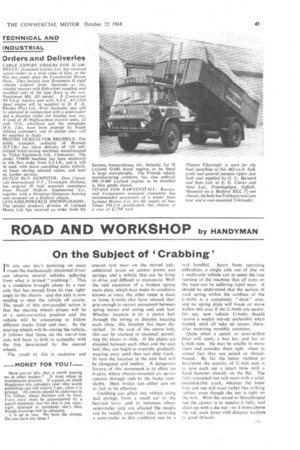ROAD AND WORKSHOP by HANDYMAN
Page 45

If you've noticed an error in this article please click here to report it so we can fix it.
On the Subject of Crabbing'
I N any one day's motoring on main roads the mechanically interested driver can observe several vehicles; suffering from what is termed "crabbing ". This is a condition brought about by a rear axle that has moved .from its true rightangle to the chassis --and this axle is now tending to steer the vehicle off course. The result of this non-parallel action is that the steering wheels proper will be in a semi-corrective position and the vehicle will be attempting to follow different tracks front and rear. As the steering wheels will be aiming the vehicle, it follows that those on the out-of-line axle will have to drift in sympathy with the line determined by the steered wheels.
Thp result of this is excessive and —MONEY FOR YOU?
Have you an idea that is worth passing on to other readers ? It must relate to maintenance practice. If a panel, on which Handyman sits, considers your idea worth publishing you will receive 3 gns. when it is printed. All entries should be addressed to The Editor, whose decision will be final. Every entry must be accompanied by a signed statement that the idea is not copyright, patented or somebody else's idea. Rough drawings will be adequate.
It is up to you. We have the money. Do you have any ideas ? uneven tyre wear on the moved axlc, additional straits on anchor points and springs, and a vehicle that can be tiring to drive and difficult to manceuvre. With the odd exception of a broken spring main plate, which may make its condition known at once, the other cause is slack or loose U-bolts that have relaxed their grip enough to permit movement between spring leaves and spring and axle bed. Whether location is by a centre bolt through the spring or dimples locating each plate, this location has been disturbed. In the case of the centre bolt. this can be cranked or snapped, permitting the plates to slide. If the Plates are dimpled between each other and the axle bed, they can begin to override. gradually wearing away until they can slide freely. In turn the location in the axle bed will be elongated and useless. A dangerous feature of this movement is its effect on brakes, where chassis-mounted air servos operate through rods to the brake camshafts. Here brakes can either jam on or fail to be effective.
Crabbing can affect any vehicle using leaf springs, from a small car to the heaviest lorry. and in instances where semi-trailer axle are affected the results can be readily expensive: also, reversing a semi-trailer in this condition can be a real handful. Apart from operating difficulties, a single axle out of line on a multi-axle vehicle can so upset the true running of the machine that all tyres on the road can be suffering rapid wear. It should be understood that the section of road spring within the confines of the U-bolts is a completely "dead" area, and no spring plate will break or move within this area if the U-bolts are secure. On any new vehicle U-bolts should receive a weekly nip-up, preferably when loaded, until all take up ceases, thereafter receiving monthly attention.
Quite often a junior or semi-skilled fitter will apply a box key and bar to U-bolt nuts. He may be unable to move them and consider them tight -when in actual fact they are seized or threadbound. By far the better method to determine the security of U-bolt nuts is to give each nut a smart blow with a hand hammer directly on the flat. The fully tensioned nut will react with a solid, unmistakable crack, whereas the loose bolt and nut will react rather like striking rubber, even though the nut is tight on the bolt. With the seized or threadbOund nut the answer is to remove it fully, and clean up with a die nut—or if worn above the nut. pack down with distance washers to good threads.




















































































































